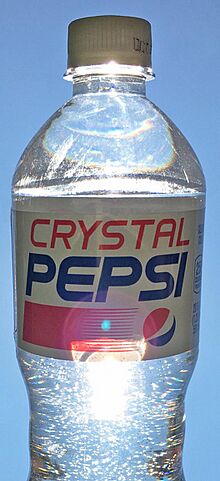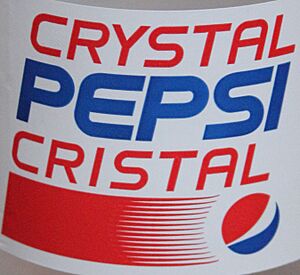Crystal Pepsi facts for kids
Quick facts for kids 
20 US fluid ounces (590 ml) in 2016
|
|
| Type | Clear cola |
|---|---|
| Manufacturer | PepsiCo |
| Country of origin | United States |
| Introduced | April 13, 1992 (test markets) |
| Discontinued | 1994 (original run) |
| Variants | Diet Crystal Pepsi, Crystal From Pepsi |
| Related products | Pepsi Blue, Tab Clear |
Crystal Pepsi was a special clear soda made by PepsiCo. It looked like water but tasted like cola! It first came out in the United States and Canada between 1992 and 1994. It was also sold for a short time in the United Kingdom and Australia.
In the early 1990s, PepsiCo wanted to try new things. They noticed that many people liked clear products, thinking they were purer or healthier. So, they worked hard to create a clear cola. They tried many ideas and recipes.
They found a way to make a lighter-tasting cola without the usual caramel color. This new drink had 20 fewer calories than regular Pepsi. Crystal Pepsi was a "totally new product" that tasted a bit less "acidic" than regular Pepsi.
Crystal Pepsi launched in 1992 with a big marketing push. It was very popular at first, earning about $474 million in its first year. However, PepsiCo made some mistakes. Also, Coca-Cola launched a similar clear drink called Tab Clear to compete. Because of these reasons, Crystal Pepsi was taken off the market in 1994. Years later, fans asked for it back, and it was re-released for short times in the 2010s.
Contents
The Story of Crystal Pepsi
Why a Clear Soda?
Did you know that Coca-Cola once made a clear cola? It was a secret drink made for a Soviet general to look like vodka. This was called White Coke.
In the 1980s and 1990s, many companies started making clear products. They wanted people to think that clear meant pure and clean. For example, Ivory soap used the slogan "99 and 44/100 percent pure." This idea inspired many clear products, including drinks.
Soft drink sales grew a lot in the 1980s, especially with diet drinks. But by 1991, sales growth slowed down. PepsiCo wanted to find new ways to grow. They looked at the fast-growing "New Age" drink market. This market included drinks like Clearly Canadian and Snapple. PepsiCo was ready to take risks and try new ideas.
How Crystal Pepsi Was Made
PepsiCo already had many product ideas. But their research showed that people wanted a healthier cola. Cola was the most popular type of soft drink, but its sales were slowing. Scientists knew that a food's color can change how it tastes. Lighter colors often make people think of lighter flavors.
Pepsi's usual caramel coloring gives it its dark color and some flavor. For Crystal Pepsi, they used modified food starch instead to keep it clear. PepsiCo created 3,000 different recipes for the new clear drink. They tested these recipes with customers. A 12-ounce serving of Crystal Pepsi had 134 calories. This was 20 fewer calories than regular Pepsi, which had 154 calories. In November 1991, Pepsi-Cola announced they were working on a colorless Pepsi.
On April 13, 1992, Crystal Pepsi was first sold in a few cities. These included Dallas, Providence, Salt Lake City, and Colorado. People really liked it! After just one month, it was clear the drink was a big hit. In Colorado, many customers also asked for Diet Crystal Pepsi. So, a diet version was launched there in October.
The Big Launch and What Happened Next
Crystal Pepsi was launched across the entire United States on December 14, 1992. In its first year, it captured 1% of all U.S. soft drink sales. This was about $474 million! On the same day, Coca-Cola launched its own clear cola, Tab Clear.
Around the same time, other companies also released clear versions of their products. There was clear Palmolive dish soap and clear Softsoap liquid soap. Even the Miller Brewing Company released a clear beer called Miller Clear.
By late 1993, Crystal Pepsi was no longer being made. The last bottles were sent to stores in early 1994. A few months later, Pepsi tried a new version called Crystal From Pepsi. This was a mix of citrus and cola flavors.
In 2005, a drink called Pepsi Clear was sold in Mexico for a short time. In 2008, PepsiCo even applied for trademarks on "Pepsi Clear" and "Diet Pepsi Clear."
How Crystal Pepsi Was Advertised
Crystal Pepsi was advertised as a "clear alternative" to regular colas. It was also caffeine-free. Its main slogan was "You've never seen a taste like this."
A PepsiCo manager explained that Crystal Pepsi was not just Pepsi without color. He said it was a "totally new product." It tasted different and was lighter and less sweet. It had "all natural flavors" and "no preservatives." PepsiCo hoped it would create a whole new type of drink. They thought 80% of its sales would come from people who didn't usually drink Pepsi. Their goal was to get 2% of the huge soft drink market by the end of 1993. This would be about $1 billion.
The marketing campaign cost $40 million. It included a special ad during the US President's inauguration. There were also $7 million worth of Super Bowl advertisements. PepsiCo even created the world's first computer-generated bus wrap printing. A series of TV ads featured Van Halen's song "Right Now." These ads first aired on January 31, 1993, during Super Bowl XXVII. The ad was so famous that the TV show Saturday Night Live made a funny version called Crystal Gravy. Free sample bottles were even given out with Sunday newspapers.
According to Coca-Cola's marketing chief, Sergio Zyman, Tab Clear was launched on purpose to "kill both" Crystal Pepsi and Tab Clear itself. He called it a "kamikaze" effort. They used the less popular Tab brand. They also labeled it "sugar free" to make people think Crystal Pepsi had no sugar. Zyman said, "Both of them were dead within six months."
Yum! Brands chairman David C. Novak helped create the idea for Crystal Pepsi. In an interview, he said it was a "tremendous learning experience." He still thinks it was his best idea but the worst one he ever carried out. He realized he should have made sure the product tasted good. He learned that if you have a great idea but mess it up, you might not get another chance.
See also
- Coca-Cola Clear
- List of defunct consumer brands
- List of Pepsi types
- New Coke
- Zima


